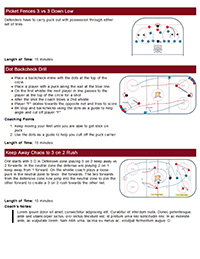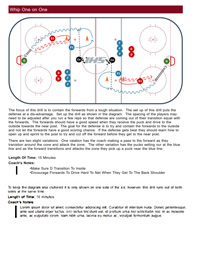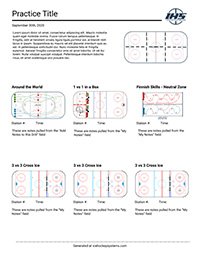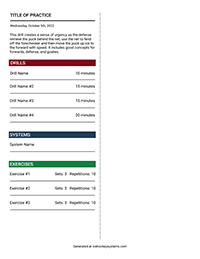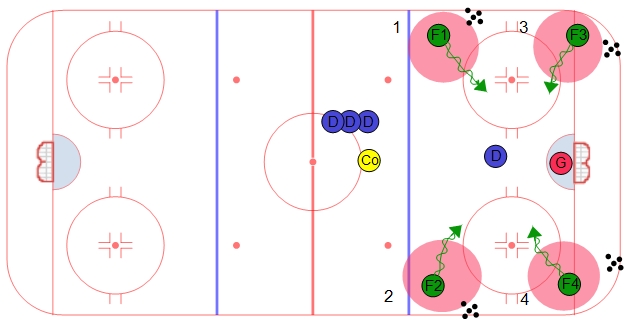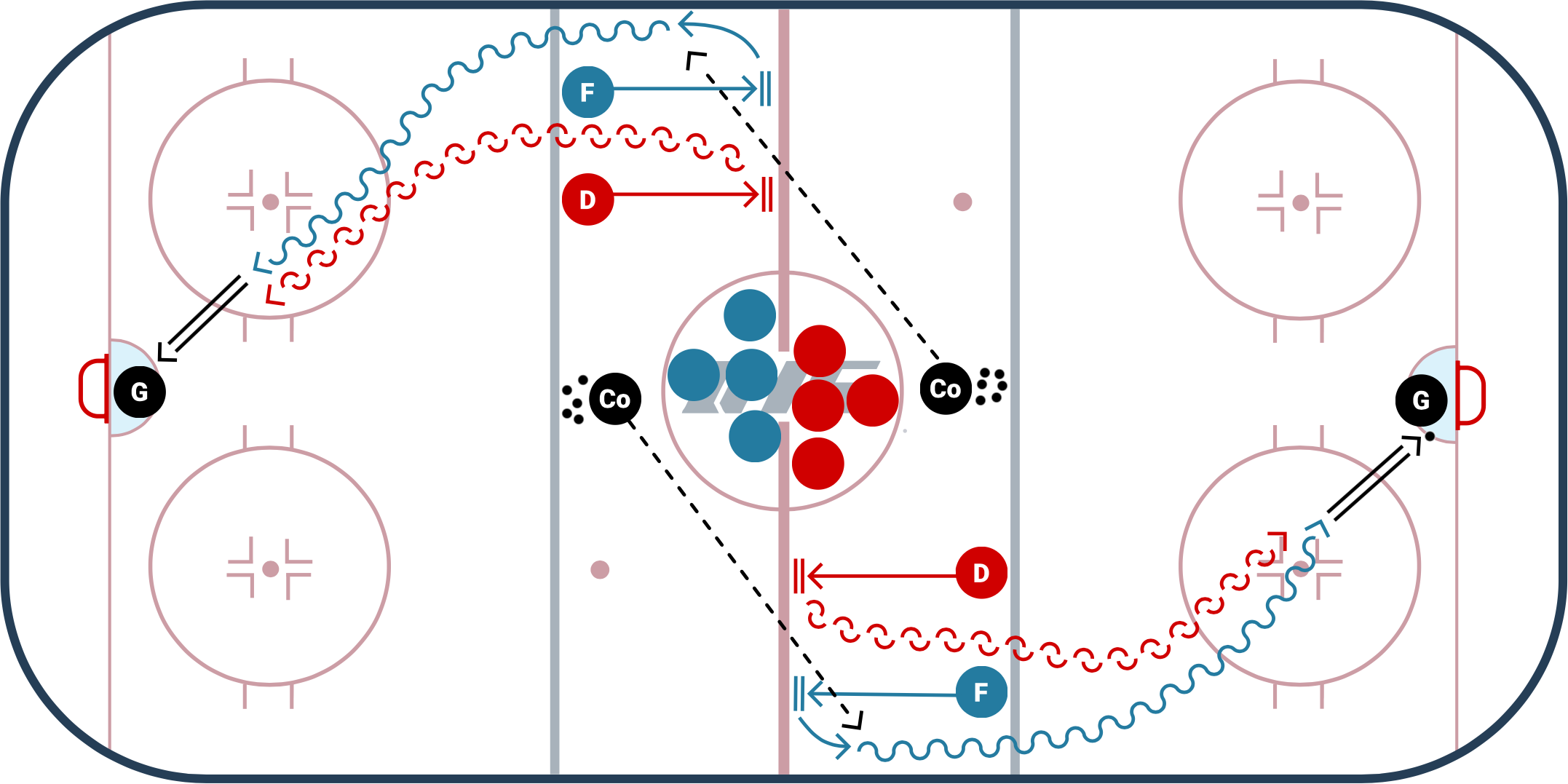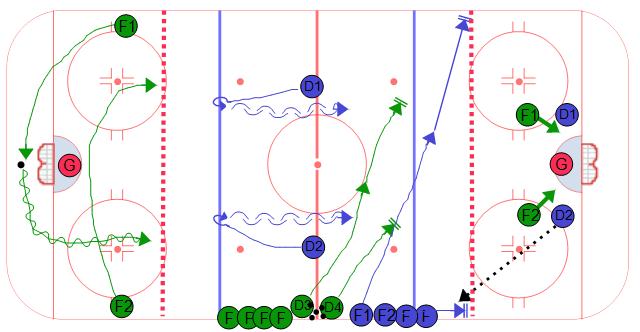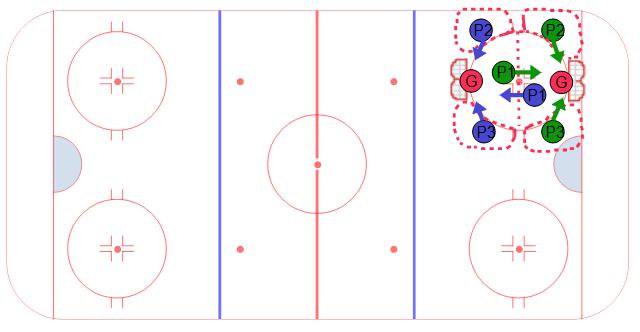
Midget / U16 / U18 Full Ice Practice #1
Midget / U16 / U18 Full Ice Practice #1

Warm Up Flow Drills (16 min.)
- Blue devils flow drill (8 min.)
- Horseshoe re-group (8 min.)
1 on 1's (20 min.)
- Four Zone 1 on 1 (10 min.)
- Danger Zone 1 on 1 (10 min.)
2 on 2 (15 min.)
- Continuous 2 on 2
Game (remaining)
- Quarter Ice 3 vs 3
Practice Layout
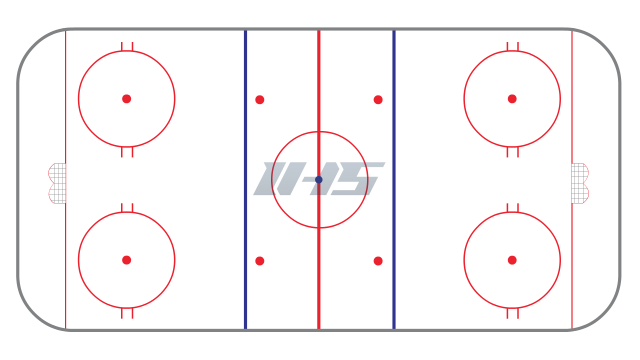
Blue Devils Flow Drill
This ice hockey flow drill is great to work on timing and communication. Both P1's start the drill on a whistle with a puck in the high slot and take a shot, after that there should be no more whistles needed. After the shot, P1's pick up a puck from the corner and start the passing breakout. P2's and P3's should start there routes just before the P1's take their shots. When the breakout is complete the P3's become the new P1's keeping the flow going. Make sure that P2's and P3's take deep routes and time their routes properly so that they are receiving more of a horizontal pass than a vertical pass. Make sure that there are plenty of pucks in the corners. If a player misses a pass it's important for them to keep going so the sides stay equally separated. If the timing gets off, we recommend to restart at both ends on a whistle.
Horseshoe Re-Group Drill
Great drill here if your looking for a flow drill that involves a lot of players, passing, shooting, and skating. The setup is similar to the typical horseshoe drill with two lines in opposite corners with pucks except now there are four defense at center ice as shown. Two players from each line will go on the whistle. The first player will start at the hash marks with a puck, the second player will start on the goal line and put pressure on the first player from behind (the goal is to catch the puck carrier if possible). The first player should attack the blue line inside out and take a shot from the top of the circles and follow their shot to the net. The first player will stop at the net and then sprint out to the neutral zone to time their entry back into the zone and hunt a rebound. The second player will swing through the neutral zone and receive a pass from the opposite corner. They will carry the puck to the red line and make a pass to the defense. The defense will pass the puck from defense to defense and then pass back to the second player as they swing through the neutral zone. The second player then attacks the zone and takes a wide angle shot with the intent of creating a rebound for the player hunting a rebound. After a few repetitions have two new defense replace the defense in the middle and keep rotating every couple of repetitions.
Four Zone 1 on 1
This drill can be very challenging for defensive players. The drill forces players to work on taking away time ans space in the defensive zone, recovering from a disadvantageous position, and stamina.
To set up the drill place four lines of players in each corner of the zone with pucks as shown in the diagram. The coach will name each line 1,2,3, or 4. Make sure all players are fully aware of the label for each line. The defensive player will start in the middle.
To start the drill the coach yells out a number. The first player in that line will attack the net. The defensive player has to react and play the 1 on 1. On the whistle, that play stops and the coach yells out a new number from which the next player attacks the net 1 on 1. This sequence repeats 4 times so that the defensive player plays four 1 on 1's, one out of each zone.
Danger Zone 1 on 1
Welcome to the Danger Zone!
This one on one drill focuses on an area of the ice where a lot of turnovers occur. Being able to transition quickly will help generate scoring chances. This drill sets players up in a situation where the sole purpose is to have them keep moving their feet as they enter the zone, fighting through the check if they have to.
Setup
- This can be set up as a full ice (as shown in the video), or half ice on both sides, or as a station drill.
- The drill is set up with the pucks and coaches in the middle of the ice at about the edge of the center face-off circle with pucks. The extra players are inside the center circle out of the way. The forward starts on the blue line along the wall and the defense start on the blue line just inside the dots.
- On the whistle, both players skate up to the red line and stop. The forward calls to receive a pass from the coach (or another player) and the defense transitions backwards... then the danger zone starts!
- Variation: If the defense is getting beat too often, you can have them stop or pivot backwards in between the blue line & center line, which will give them a bit of a head start on the forwards.
Forward Options
- Outside Option: The first is to use their speed and gain the zone to the outside. If the defense is able to play them at the blue line then they can give themselves a soft chip inside the zone and keep their feet moving through the check.
- Middle of Ice Option: If the defense does not do a good job at the blue line and allows the forward to enter the zone with space then the forward can cut to the middle of the ice. It is important that the forwards get the puck down deep into the zone in this situation.
- Get Creative! Anything goes! Change up your skating speed and tempo, use deceptive moves with your body and puck control to get the defenceman off balance, etc. Have fun and work to survive the danger zone!
Defense Coaching Points
- Try and match the speed of the attacker and keep stick on ice.
- Keep your eyes focused on the chest, not the puck so you can play and angle the body.
- The defense should take away as much space as possible and pressure the forward at or before the blue line.
- Do not get stuck by crossing over to many times. If you cross over too many times and start to move lateral, it gives the forward an option to get you off balance and skate the other way. Watch the video demo below "Backwards Crossover Start" for tips to immediately gain speed and not lose your balance.
- Try to go blade on the blade while finishing with your body.
This 1 on 1 drill is for a very specific part of the ice. More 1 on 1 situational drills can be viewed on our 1 on 1 hockey drills page.
Continuous 2 on 2 Hockey Drill
There are several defensive minded key points to this hockey drill. The first is the gap control. The defense should never give up the blue line because it is always a 2 on 2. Offensively, forwards need to make smart plays and chip the puck into the zone instead of trying to beat guys at the blue line.
Down low in the defensive zone the defense need to play tight man on man and make sure not to get beat back to the front of the net. The defense need to limit the time and space of the forwards. The forwards down low in the offensive zone need to maintain possession of the puck and be patient to limit turnovers.
The drill starts with two forwards in one zone at the hash marks and a puck behind the net. The defense start inline with the dots at center ice. On the whistle one forward swings behind the net and picks up the puck, the other swings in front of the net. The two forwards attack the two defense 2 on 2. Once they cross the offensive blue line, two new forwards sprint out to the breakout positions at the top of the circle (they cannot go below the top of the circle). Two new defense also come out to the blue line and should position themselves inline with the dots. Meanwhile, in the 2 on 2 down low, the defense will try to get the puck and make a breakout pass to one of the two new forwards. The two on two is then going the other way against the two new defense.
If the goalie feezes the puck or a goal is scored, the coach plays a new puck into the active zone.
View more of our defensive hockey drills.
Quarter Ice 3 vs. 3
Players and goalies tend to love this game. It is a 3 on 3 game played in a very small area and therefore players create lots of scoring chances and goalies are very active. The game is played using two nets, one on each end of the face off circle. One player from each team is allowed inside the circle and is only allowed on the defensive half. The other two players are on the offensive side of the circle but cannot go inside the circle. Allow players to play for 45 seconds and then either switch out players or offer a rest to keep the pace of play high.
